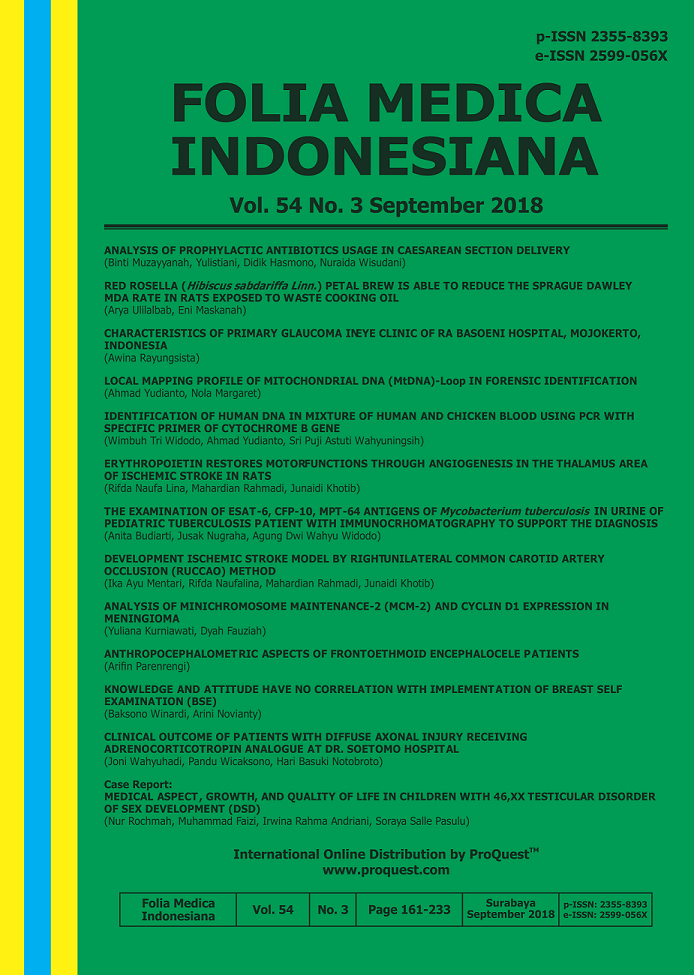Main Article Content
Abstract
Keywords
Article Details
-
Folia Medica Indonesiana is a scientific peer-reviewed article which freely available to be accessed, downloaded, and used for research purposes. Folia Medica Indonesiana (p-ISSN: 2541-1012; e-ISSN: 2528-2018) is licensed under a Creative Commons Attribution 4.0 International License. Manuscripts submitted to Folia Medica Indonesiana are published under the terms of the Creative Commons License. The terms of the license are:
Attribution ” You must give appropriate credit, provide a link to the license, and indicate if changes were made. You may do so in any reasonable manner, but not in any way that suggests the licensor endorses you or your use.
NonCommercial ” You may not use the material for commercial purposes.
ShareAlike ” If you remix, transform, or build upon the material, you must distribute your contributions under the same license as the original.
No additional restrictions ” You may not apply legal terms or technological measures that legally restrict others from doing anything the license permits.
You are free to :
Share ” copy and redistribute the material in any medium or format.
Adapt ” remix, transform, and build upon the material.

References
- Anderson DJ, Sexton DJ (2017). Antimicrobial prophylaxis for prevention of surgical site infection in adults. Available from www.uptodate.com. Accessed on February 10, 2017, 1-37
- APhA (2013). Drug information handbook a comprehensive resource for all clinicians and health-care prefessionals 22th editions. Ohio, Lexi-comp
- Berghella V (2016). Cesarean delivery: Preoperative issues. Available at: www.uptodate.com. Accessed on February 10, 2017, 1-25
- Bratzler DW, Dellinger EP, Olsen KM, et al (2013). Clinical practice guidelines for antimicrobial prophylaxis in surgery. American Journal of Health-System Pharmacy 70, 195-283
- Chileshe E (2014). Determination of C-reactive protein levels in blood of post caesarean section mothers at the University Teaching Hospital, Lusaka. Dissertation University of Zambia, 1-35
- Clifford V, Daley A (2012). Antibiotic prophylaxis in obstetric and gynaecological procedures: A review. Australian and New Zealand Journal of Obstetrics and Gynaecology 52, 412-419
- Cunningham FG, Leveno KJ, Bloom SL, et al (2010). Williams Obstetrics, Twenty-Third Edition. The United States of America, The McGraw-Hill Companies, Inc, p 587-608
- Levison ME, Levison JH (2009). Pharmacokinetics and pharmacodynamics of antibacterial agents. Infectious Disease Clinics of North America 791-815
- Nightingale CH, Ambrose PG, Drusano GL, et al (2007). Antimicrobial pharmacodynamics in theory and clinical practice, second edition. New York, Informa Healthcare, p 129-146
- Schalkwyk JV, Eyk NV (2010). Antibiotic prophylaxis in obstetric procedures. SOGC Clinical Practice Guideline. Juornal of Obstetrics and Gynecology Canada, 878-884
- Smaill FM, Gyte GML (2010). Antibiotic prophylaxis versus no prophylaxis for preventing infection after cesarean section. Cochrane Database of Systematic Reviews, 1-176
- Ullman MA, Rotschafer JC (2016). Antimicrobial prophylaxis in surgery. In Chisholm-Burns MA. Schwinghammer TL, Wells BG, et al. Pharmacotherapy Principles & Practice Fourth Edition. New York, McGraw-Hill Education, p 1247-125
References
Anderson DJ, Sexton DJ (2017). Antimicrobial prophylaxis for prevention of surgical site infection in adults. Available from www.uptodate.com. Accessed on February 10, 2017, 1-37
APhA (2013). Drug information handbook a comprehensive resource for all clinicians and health-care prefessionals 22th editions. Ohio, Lexi-comp
Berghella V (2016). Cesarean delivery: Preoperative issues. Available at: www.uptodate.com. Accessed on February 10, 2017, 1-25
Bratzler DW, Dellinger EP, Olsen KM, et al (2013). Clinical practice guidelines for antimicrobial prophylaxis in surgery. American Journal of Health-System Pharmacy 70, 195-283
Chileshe E (2014). Determination of C-reactive protein levels in blood of post caesarean section mothers at the University Teaching Hospital, Lusaka. Dissertation University of Zambia, 1-35
Clifford V, Daley A (2012). Antibiotic prophylaxis in obstetric and gynaecological procedures: A review. Australian and New Zealand Journal of Obstetrics and Gynaecology 52, 412-419
Cunningham FG, Leveno KJ, Bloom SL, et al (2010). Williams Obstetrics, Twenty-Third Edition. The United States of America, The McGraw-Hill Companies, Inc, p 587-608
Levison ME, Levison JH (2009). Pharmacokinetics and pharmacodynamics of antibacterial agents. Infectious Disease Clinics of North America 791-815
Nightingale CH, Ambrose PG, Drusano GL, et al (2007). Antimicrobial pharmacodynamics in theory and clinical practice, second edition. New York, Informa Healthcare, p 129-146
Schalkwyk JV, Eyk NV (2010). Antibiotic prophylaxis in obstetric procedures. SOGC Clinical Practice Guideline. Juornal of Obstetrics and Gynecology Canada, 878-884
Smaill FM, Gyte GML (2010). Antibiotic prophylaxis versus no prophylaxis for preventing infection after cesarean section. Cochrane Database of Systematic Reviews, 1-176
Ullman MA, Rotschafer JC (2016). Antimicrobial prophylaxis in surgery. In Chisholm-Burns MA. Schwinghammer TL, Wells BG, et al. Pharmacotherapy Principles & Practice Fourth Edition. New York, McGraw-Hill Education, p 1247-125

